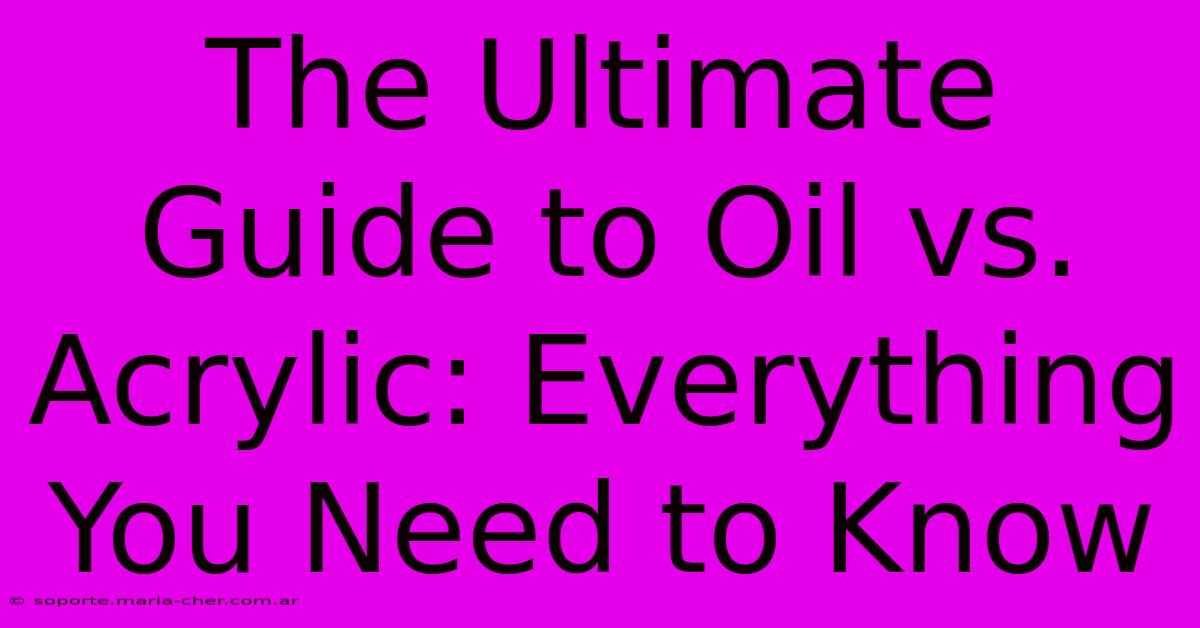The Ultimate Guide To Oil Vs. Acrylic: Everything You Need To Know

Table of Contents
The Ultimate Guide to Oil vs. Acrylic: Everything You Need to Know
Choosing between oil and acrylic paints can feel overwhelming, especially for beginners. Both mediums offer unique characteristics and advantages, making the "right" choice entirely dependent on your individual needs and artistic style. This comprehensive guide will delve into the key differences between oil and acrylic paints, helping you make an informed decision.
Oil Paints: The Timeless Classic
Oil paints have been the favored medium of artists for centuries, celebrated for their rich, luminous colors and unparalleled blending capabilities. Their slow drying time allows for extensive blending and layering, creating depth and richness in the artwork.
Advantages of Oil Paints:
- Blending and Layering: The slow drying time is a major advantage, providing ample opportunity for seamless blending and creating subtle gradations of color. Multiple layers can be applied, building up texture and depth.
- Rich, Vibrant Colors: Oil paints possess an inherent luminosity, resulting in vibrant and saturated colors that retain their intensity over time.
- Permanence: Oil paintings, when properly cared for, are renowned for their longevity, lasting for centuries.
- Texture and Detail: The flexibility of oil paint allows for the creation of a wide range of textures, from smooth and subtle to heavily impastoed.
Disadvantages of Oil Paints:
- Drying Time: The slow drying time, while advantageous for blending, can be a drawback for artists who prefer quicker results. It also necessitates the use of solvents for cleanup.
- Cleanup: Cleaning up oil paints requires the use of solvents like turpentine or mineral spirits, which are potentially harmful if not handled correctly.
- Cost: Oil paints and supplies, including mediums and solvents, can be more expensive than acrylics.
- Odor: Oil paints and solvents have a distinct odor, which may be unpleasant for some artists.
Acrylic Paints: The Versatile Modern Choice
Acrylic paints have gained immense popularity due to their versatility, ease of use, and quick drying time. Water-based, they offer a convenient and less toxic alternative to oil paints.
Advantages of Acrylic Paints:
- Fast Drying Time: Acrylics dry quickly, allowing for rapid layering and completion of artwork. This is a major benefit for artists who prefer immediate results.
- Easy Cleanup: Cleanup is simple, requiring only soap and water.
- Versatility: Acrylics can be used on a variety of surfaces, including canvas, wood, paper, and fabric. They can be thinned with water to create washes or applied thickly for impasto effects.
- Cost-Effective: Acrylic paints and supplies are generally less expensive than oil paints.
- Less Odor: Acrylics have a minimal odor, making them a suitable choice for artists with sensitivities to strong fumes.
Disadvantages of Acrylic Paints:
- Fast Drying Time: While advantageous for some, the quick drying time can limit blending opportunities and make achieving subtle color transitions more challenging.
- Less Luminous Colors: Compared to oil paints, acrylics may appear less luminous, though advancements in paint technology are constantly improving this aspect.
- Less Flexible: Once dry, acrylics become less flexible than oil paints, making them more prone to cracking or flaking over time, particularly on flexible surfaces.
Choosing the Right Medium for You:
Ultimately, the best choice depends on your preferences and artistic goals.
-
Choose oil paints if: You enjoy a slow, deliberate painting process, value rich, luminous colors and enjoy extensive blending and layering. You don't mind the slower drying time, cleanup process, and associated costs.
-
Choose acrylic paints if: You prefer a fast-paced painting style, appreciate the convenience of water-based cleanup, and require versatility in application and surfaces. The slightly less luminous colors and faster drying time are not significant drawbacks for your style.
Beyond the Basics: Exploring Medias and Techniques
Both oil and acrylic paints offer a wealth of possibilities through the use of various mediums and techniques. Experimentation is key to discovering your preferred methods and achieving your artistic vision.
This comprehensive guide provides a solid foundation for understanding the nuances of oil and acrylic paints. With this knowledge, you're well-equipped to embark on your artistic journey with confidence, selecting the medium that best suits your creative style and aspirations. Remember to research further and explore the vast resources available to learn more about specific techniques and applications for each medium.

Thank you for visiting our website wich cover about The Ultimate Guide To Oil Vs. Acrylic: Everything You Need To Know. We hope the information provided has been useful to you. Feel free to contact us if you have any questions or need further assistance. See you next time and dont miss to bookmark.
Featured Posts
-
Voyage To The Past Dossin Great Lakes Museum Webcam Connects You To Maritime Marvels
Feb 10, 2025
-
Unlock The Secret To Color Confidence The F M 100 Hue Test For Unwavering Style
Feb 10, 2025
-
Maximize Retention Learn The Power Of Memorization Vs Recitation
Feb 10, 2025
-
The Power Of Dd How To Find Your Perfect Nail Color Match
Feb 10, 2025
-
Unveiled The Secrets Of The Ethereal Pink And White Rose
Feb 10, 2025
